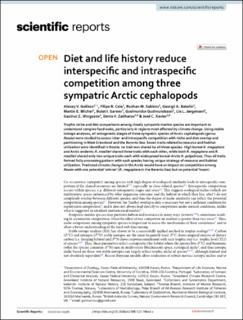| dc.contributor.author | Golikov, Alexey V. | |
| dc.contributor.author | Ceia, Filipe R. | |
| dc.contributor.author | Sabirov, Rushan M. | |
| dc.contributor.author | Batalin, Georgii A. | |
| dc.contributor.author | Blicher, Martin E. | |
| dc.contributor.author | Gareev, Bulat I. | |
| dc.contributor.author | Gudmundsson, Gudmundur | |
| dc.contributor.author | Jørgensen, Lis Lindal | |
| dc.contributor.author | Mingazov, Gazinur Z. | |
| dc.contributor.author | Zakharov, Denis | |
| dc.contributor.author | Xavier, José C. | |
| dc.date.accessioned | 2021-04-26T11:45:35Z | |
| dc.date.available | 2021-04-26T11:45:35Z | |
| dc.date.created | 2021-03-17T14:34:17Z | |
| dc.date.issued | 2020 | |
| dc.identifier.citation | Scientific Reports. 2020, 10 (1), . | en_US |
| dc.identifier.issn | 2045-2322 | |
| dc.identifier.uri | https://hdl.handle.net/11250/2739591 | |
| dc.description.abstract | Trophic niche and diet comparisons among closely sympatric marine species are important to understand complex food webs, particularly in regions most affected by climate change. Using stable isotope analyses, all ontogenetic stages of three sympatric species of Arctic cephalopods (genus Rossia) were studied to assess inter- and intraspecific competition with niche and diet overlap and partitioning in West Greenland and the Barents Sea. Seven traits related to resource and habitat utilization were identified in Rossia: no trait was shared by all three species. High boreal R. megaptera and Arctic endemic R. moelleri shared three traits with each other, while both R. megaptera and R. moelleri shared only two unique traits each with widespread boreal-Arctic R. palpebrosa. Thus all traits formed fully uncrossing pattern with each species having unique strategy of resource and habitat utilization. Predicted climate changes in the Arctic would have an impact on competition among Rossia with one potential ‘winner’ (R. megaptera in the Barents Sea) but no potential ‘losers’. | en_US |
| dc.language.iso | eng | en_US |
| dc.title | Diet and life history reduce interspecific and intraspecific competition among three sympatric Arctic cephalopods | en_US |
| dc.type | Peer reviewed | en_US |
| dc.type | Journal article | en_US |
| dc.description.version | publishedVersion | en_US |
| dc.source.pagenumber | 0 | en_US |
| dc.source.volume | 10 | en_US |
| dc.source.journal | Scientific Reports | en_US |
| dc.source.issue | 1 | en_US |
| dc.identifier.doi | 10.1038/s41598-020-78645-z | |
| dc.identifier.cristin | 1898707 | |
| cristin.ispublished | true | |
| cristin.fulltext | original | |
| cristin.qualitycode | 1 | |
